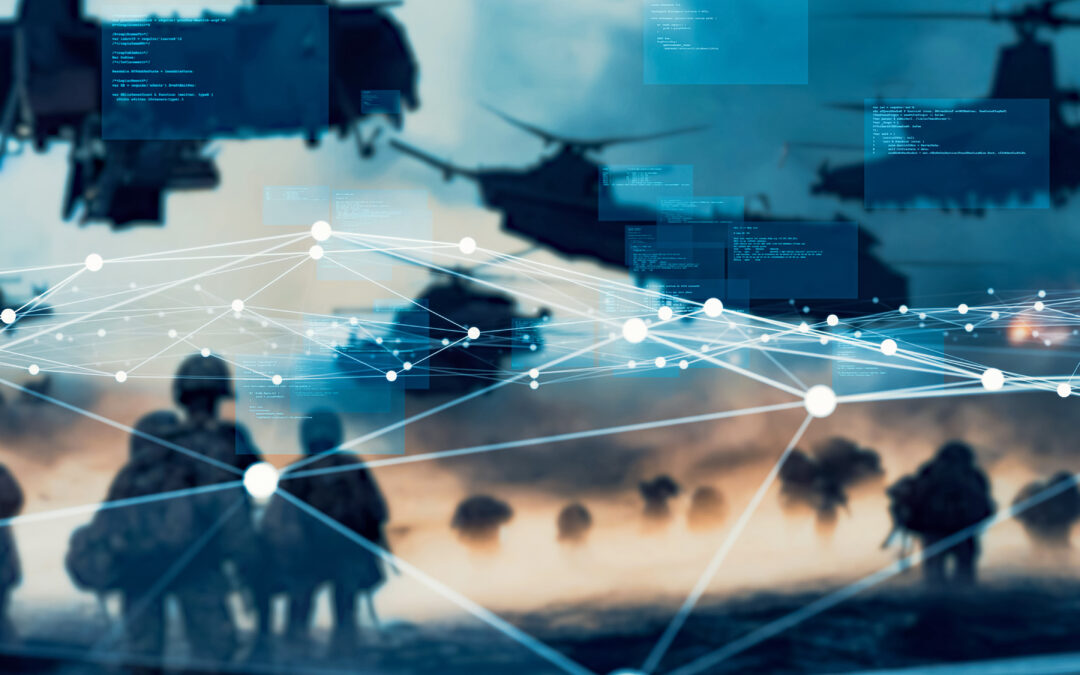As we step into 2024, the landscape of military and defense technology is evolving at a rapid pace, reshaping the way nations safeguard their interests and maintain security. In this era of unprecedented innovation, several key trends are set to dominate the sphere of military and defense technology. From the integration of Artificial Intelligence (AI) to the advancement of Military Robotics and Autonomous Systems (RAS) technology, the ever-escalating arena of Cyber Warfare, the power of Big Data and Analytics, to the transformative potential of 5G Connectivity, the world of defense is poised for a revolution. In this article, we will delve into the top 5 trends that are driving military and defense innovation in 2024 and beyond, showcasing how these developments are reshaping the very nature of modern warfare and security strategies.
Artificial Intelligence
In the ever-evolving landscape of defense technology and strategy, AI has emerged as a paramount trend in the year 2024. Its unmatched potential to revolutionize military operations has positioned AI at the forefront of innovation, offering capabilities that enhance decision-making, optimize resource allocation, and redefine the nature of modern warfare. This article explores the multifaceted impact of AI in defense, emphasizing its role in predictive analytics, automation, and cybersecurity.
Key Contributions of AI in Defense:
- Data Processing Power: AI’s ability to rapidly process vast volumes of data provides military decision-makers with invaluable insights. This capability enables the anticipation of threats, enhancing the speed and accuracy of strategic decision-making.
- Tactical Advantage: The predictive and analytic power of AI empowers military commanders with a tactical edge, fostering more informed and timely decisions. This advantage contributes to increased mission success rates and overall operational efficiency.
- Autonomous Systems: AI’s adaptability and automation capabilities find practical applications in autonomous systems. Unmanned aerial vehicles (UAVs) and ground-based robotic systems integrated with AI conduct reconnaissance, logistics, and combat operations, reducing risks to human lives and expanding the operational reach of defense forces.
- Cyber Defense: AI plays a crucial role in bolstering cyber defense efforts. AI-powered tools aid in the identification and mitigation of cyber threats and vulnerabilities, enhancing the resilience of military networks and information security.
As AI continues to advance, its influence on the defense sector remains imperative. The transformative capabilities and potential applications of AI promise to redefine the landscape of modern warfare. From revolutionizing decision-making processes to automating critical operations, AI stands as a driving force in shaping the future of defense technology.
Military Robotics & Autonomous Systems (RAS) Tech
In a groundbreaking era of defense innovation, the deployment of Robotic and Autonomous Systems (RAS) underscores a commitment to enhancing operational capabilities through relentless technological pursuit. These autonomous systems, spanning UAVs to ground-based robotic units, serve as a force multiplier, augmenting human forces with unparalleled agility, precision, and versatility across various mission profiles. As a critical development, RAS technology minimizes human exposure to hazardous conditions while extending operational reach. Capable of executing reconnaissance, surveillance, logistics, and combat roles independently or collaboratively with human forces, the integration of artificial intelligence into RAS enhances adaptability and decision-making in dynamic battlefield scenarios. The continued development and implementation of RAS technology promises a secure and efficient landscape in 2024 and beyond.
Cyber Warfare
In 2024, the enduring significance of cyber warfare emerges as a pivotal trend, driven by the interconnected fabric of our modern world where digital systems underpin nearly every facet of society and military infrastructure
The critical need for cyber warfare:
- Interconnected Vulnerabilities: Heightened vulnerabilities stemming from the interdependence of digital systems underscore the need for robust defense against evolving cyber threats.
- Diverse Threat Landscape: Beyond state-sponsored actors, cyber warfare in 2024 involves non-state entities and cybercriminal organizations, offering a versatile tool for achieving strategic goals like espionage, disruption, or economic sabotage.
- Sophistication and Proliferation: The increasing sophistication and proliferation of cyber threats emphasize the urgency for proactive cyber defense strategies, prompting defense sectors to innovate in cybersecurity measures.
- Specialized Defense Capabilities: Nurturing specialized cyber defense capabilities is crucial for safeguarding critical information, infrastructure, and national security interests in the face of an evolving threat landscape.
The persistent trend of cyber warfare in 2024 highlights the necessity for adapting to an evolving digital battlefield. Safeguarding technological infrastructure, national sovereignty, and security requires continuous innovation in cybersecurity, positioning it as a paramount aspect of defense strategies for the years ahead.
Big Data and Analytics
Big data and analytics are set to wield a profound influence over defense innovation in 2024, fundamentally reshaping the decision-making processes and operational capabilities of military organizations.
Here are a few ways in which big data and analytics are enhancing decision-making:
- Data as Strategic Resource: The increasing volume of data from sensors, satellites, and communication networks serves as a valuable resource for defense strategists, offering insights for informed decision-making.
- Advanced Analytics and Machine Learning: Through the application of advanced analytics and machine learning algorithms, military leaders can extract patterns, trends, and potential threats from the vast data trove, enhancing the effectiveness of data-driven decision-making.
- Real-time Analysis and Predictive Analytics: Real-time analysis of big data facilitates rapid responses to emerging challenges, improves situational awareness, and uncovers hidden correlations. The integration of predictive analytics empowers defense agencies to anticipate and proactively address security threats
In sum, the fusion of big data and analytics in the defense sector holds the potential to unlock innovative solutions, improve resource allocation, and enhance the overall efficiency and effectiveness of military operations, positioning it as a pivotal trend in 2024.
5G Connectivity
5G connectivity continues to be a paramount trend in the military and defense sector in 2024 due to the transformative potential it offers in terms of communication, data transfer, and operational capabilities. The significance of 5G lies in its unparalleled speed and low latency, which facilitate real-time data transmission and enable the seamless integration of various technologies on the battlefield. This high-speed connectivity enhances the efficiency of military operations by enabling swift decision-making, remote piloting of drones and autonomous systems, and the exchange of critical information across distributed forces.
Moreover, 5G networks are inherently more secure and resilient, offering robust encryption and advanced security features, which are essential for safeguarding sensitive military data and communications from cyber threats. These attributes make 5G a crucial enabler for secure communication and coordination in the modern defense landscape. As defense agencies increasingly adopt 5G technology and explore its potential applications, it stands as a prevailing trend, poised to revolutionize the way military forces operate, share information, and maintain a tactical edge in 2024 and beyond.
Partner with Performance Defense
In the ever-evolving world of military and defense technology, the year 2024 presents a landscape where innovation is not merely an option but an imperative.
As we look forward, we encourage readers and defense stakeholders to embrace these trends and leverage them to their fullest potential. Partnering with leaders like Performance Defense can facilitate the seamless incorporation of these technologies into mission-critical solutions, ensuring that the defense industry remains at the forefront of innovation and prepared to address the complex challenges of the 21st century. Together, we can harness the power of AI, RAS, cyber defense, data analytics, and 5G to shape a more secure and efficient future for military and defense operations, bolstering the security and well-being of nations worldwide.





